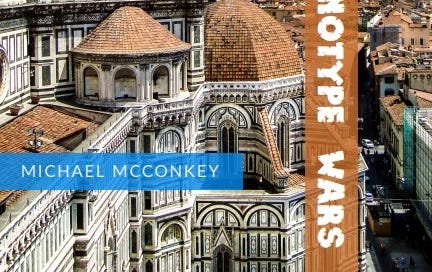Greetings gang! Your faithful Substacker was laid-low by an annoying summer cold last week, but we’re back in the saddle. Before though jumping right back into the Guilds, Old and New, series, I thought a brief refresher on some core ideas around here might be helpful. People have been asking me why I insist on using the political terms of right and left in what they regard as some obsolete or arcane way. The fullest answer to that question is to read my book, A Plea for Time in the Phenotype Wars.
I do appreciate though that there has been a slew of new subscribers and followers during the present year, many of whom have not read that book. (Interestingly, over this half year I’ve lost a bunch of subscribers and followers, too, whom I suppose don’t have an appetite for the deep dive down the rabbit hole of our historical sociology of medieval pluralism. Who knew?) However, for any newer readers, who haven’t appreciated what I’ve been up to these past six months (and haven’t read the book), I'm happy to provide a brief restatement and reminder.
Leaving the details to the book, I've argued that we should adhere to the original meaning of these terms — right and left — as forged in the caldron of the French Revolution, in which (to apply my shorthand nomenclature) the left represents ambitions for a mass society, while the right aspires to a pluralist society (see here). From a purely political perspective, maintaining such distinction is vital. If we succumb to the vernacular argot, in which the Overton window allows only legitimate debate within the mass society closed circuit of whether we should have bigger government or freer markets, we have been completely captured by the hegemony of the left worldview.
Not only were the advocates of each of those positions standing together on the left side of the French National Assembly during the revolution, but that revolution demonstrated that free markets were forged by the powerful intervention of the monist sovereign, which destroyed the intermediary institutions and customary law which had historically protected people from the danger of such unfettered markets and their "creative destruction." And as we've seen in my book and on this Substack, such has been the story elsewhere: amid the English enclosure actions; in England's pacification of Scotland; in the battle between the German bureaucratic nationalists and the German hometowns, etc.
Likewise, once the intermediary institutions, gemeinschaft, and customary law of pluralism has been destroyed, all that remained culturally of a people was an aggregation of modular individuals. For a species so profoundly, indeed uniquely, social as humans, the more such intermediary substrata of identity and meaning construction are erased, the only remaining source of mutual aid and companionship becomes a Rousseauian melding into the abstract body of the monist sovereign. By freeing markets the monist sovereign empowered itself.
Free markets and monist sovereignty are not enemies, but mutually dependent cooperators, even if they do not always agree upon the exact ideal proportion of ingredients in its mass society recipe. It's in the face of this understanding that I concluded that some recovery of pluralism — not coalitional, but at least hierarchical, but ultimately heterarchical pluralism (see here) — was an essential response to the current social malaise. As the book illustrates, we are riding over the decisive arc of a recurring historical cycle (spiral), which presents the danger of devastating collapse.
It was in response to that risk that I've proposed the importance of recovering something of the lost pluralism. Not that I claim the arc can be ultimately avoided or reversed — though history shows restorations can put off the march of destiny for many decades — but rather in the hope that humanity has in place pluralist, temporalist institutions, as widely as possible given the facts of history, to soften the landing: to indeed maybe help a crash feel more like an emergency landing. Achieving all that though is vastly more difficult when the pluralist tradition has been strategically expunged from the left-right discussion.
So my insistence upon historical originalism, if you will, is not based in nitpicky scholastics or cultural antiquarianism. Though, the fact that these are the original meanings of the words, among those who have left us this linguistic legacy, and the fact that our current bastardization of that legacy, far from being produced by some organic emergence, is really the product of ideological warfare (intended to write the right — with its appeal to medieval pluralism — out of history), would be sufficient grounds for insisting upon historical accuracy and fidelity.
My insistence though is less deontological than consequential. It is only through such historical originalism, recovering the repressed pluralism of the original right, that we can learn the lessons of that (intended to be) erased tradition which may help in the conceiving, growing, and building of alternative, intermediary institutions, which may yet offer a softer landing in the face of the collapse of the current spatialist revolution.
And that is why I've dedicated this year, so far at least, on the present Substack, to an exploration of lessons that may be learned from the much neglected history of institutional and legal pluralism. And that project resumes with the next installment of our series on Guilds, Old and New. So if this sounds like a project you'd want to stay abreast of, but haven't yet, please...
And, as ever, if you know of anyone else who’d be interested in sharing this project, please…
And, if you haven’t read my book, but really want to deeply understand the political and scholarly context of what I’ve been doing here over the last six months, I’d suggest changing that: A Plea for Time in the Phenotype Wars.
Meanwhile: Be seeing you!



